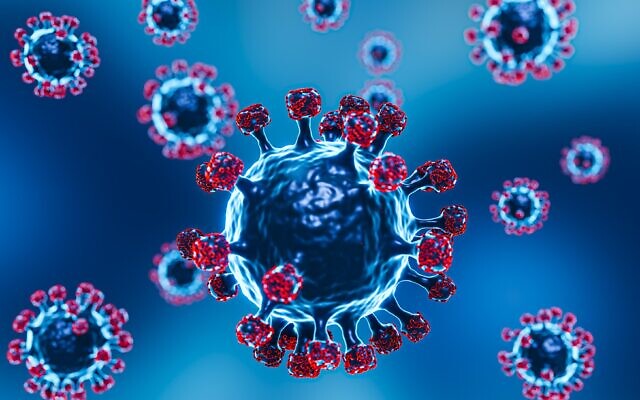COVID: Somewhat Gone but Not Forgotten
Local infectious disease physician Dr. Mitchell Blass weighed in with his perspective on the COVID-19 virus.
After 37 years with the Atlanta Journal-Constitution and now with the AJT, , Jaffe’s focus is lifestyle, art, dining, fashion, and community events with emphasis on Jewish movers and shakers.
Experts have reported that COVID-19 is on the decline in Georgia. According to the Georgia Department of Public Health, Dr. Cherie Drenzek, epidemiologist, reported in mid-October that: COVID since mid-August is down 80 percent; hospitalizations are down 89 percent; deaths in Georgia are approximately 100 per week; and 23 percent of the cases are one of the three new variants.
Local infectious disease physician Dr. Mitchell Blass weighed in with his perspective looking back on this phenomenon. Provided by Emory Saint Joseph’s Hospital, or St. Joe’s, Blass reported that there were 5,220 COVID patients treated “in patient” at St. Joe’s from March through Oct. 17.
On other parts of the virus’s mystery, Blass remarked, “Unanswered questions remain like the impact on immunity derived from previous infection with the original or new variants of COVID. We simply do not know.”
Blass noted that Fulton, DeKalb, Gwinnett, Cobb, Forsyth, and Clayton counties all are labeled “low” for infection rates. When queried about his own experiences treating COVID, Blass said, “The one thing I really wish we [physicians] could understand more clearly is why some people have a mild, often asymptomatic, course of illness and other individuals may experience a significantly more profound illness, which, on occasion, requires hospitalization. I don’t have a test, a tool, or a metric, apart from an individual patient’s previous medical history, that can be used to predict a specific patient’s risk of hospitalization or mortality from COVID.”

Some doctors have expressed caution regarding winter months potentially bringing on another surge with most people spending more time indoors due to the colder weather; or new strains coming from Europe and Asia.
Blass commented, “I have learned not to make predictions regarding an unpredictable matter. I cannot imagine that the large population that has either had the vaccination, with or without a booster, combined with the substantial population of the United States who has, at one time since 2020, had COVID (either with or without symptoms), will make it substantially unlikely that we will not see another winter such as we did in 2021.”
There is also swirling commentary about those with lingering long-term effects of COVID. He said, “At the present time, there is no consensus regarding a firm medical definition of what long COVID refers to, nor have studies definitively proven COVID to be the cause of what is termed ‘long COVID’ by many. Because this remains a relatively novel infection, and only a little under three years has passed since the first case of COVID was identified in the United States, I anticipate it will be several more years before health care providers have a clearer understanding of the long-term or lingering symptoms patients may attribute to COVID-19.”
Provoking more thought, Blass pondered, “The term ‘Muller’s Ratchet,’ attributed to Herman Joseph Muller, may provide us with some insight. It is a phenomenon, not unlike what we are experiencing now with the Omicron variant of SAR-CoV-2.
Essentially, Muller’s Ratchet explains the process through which an epidemic infection evolves over time. As mutations occur over time, the transmissible agent (virus or otherwise), becomes more contagious while at the same time, less virulent. Thus, infecting more individuals, yet causing less illness and leading to the eventual end of the epidemic.”
Timeline of COVID-19 transmission in the U.S.
* Jan. 9, 2020 – World Health Organization (WHO)
announces a mysterious Coronavirus-related
pneumonia in Wuhan, China
* Jan. 20, 2020 – Screening begins at three U.S. airports
in New York, Los Angeles, San Francisco
* Jan. 21, 2020 – First case of confirmed in Washington
state; person-to-person transmission confirmed
* Jan. 31, 2020 – WHO issues a global health
emergency
* Feb. 2, 2020 – Global air travel is restricted
* Feb. 3, 2020 – U.S. declares a public health emergency
* March 2, 2020 – First case of SARS-CoV-2 in Georgia
* Dec. 11, 2020 – First COVID-19 vaccination available
- Health and Wellness
- Local
- Marcia Caller Jaffe
- COVID-19
- pandemic
- Georgia Department of Public Health
- Dr. Cherie Drenzek
- Dr. Mitchell Blass
- Emory Saint Joseph's Hospital
- Fulton
- DeKalb
- Gwinnett
- Cobb
- Forsyth
- and Clayton counties
- vaccination
- Boosters
- Muller’s Ratchet
- Herman Joseph Muller
- Omicron variant
- World Health Organization (WHO)
- Wuhan
- China
- Coronovirus
- New York
- Los Angeles
- San Francisco
- SARS-CoV-2




comments